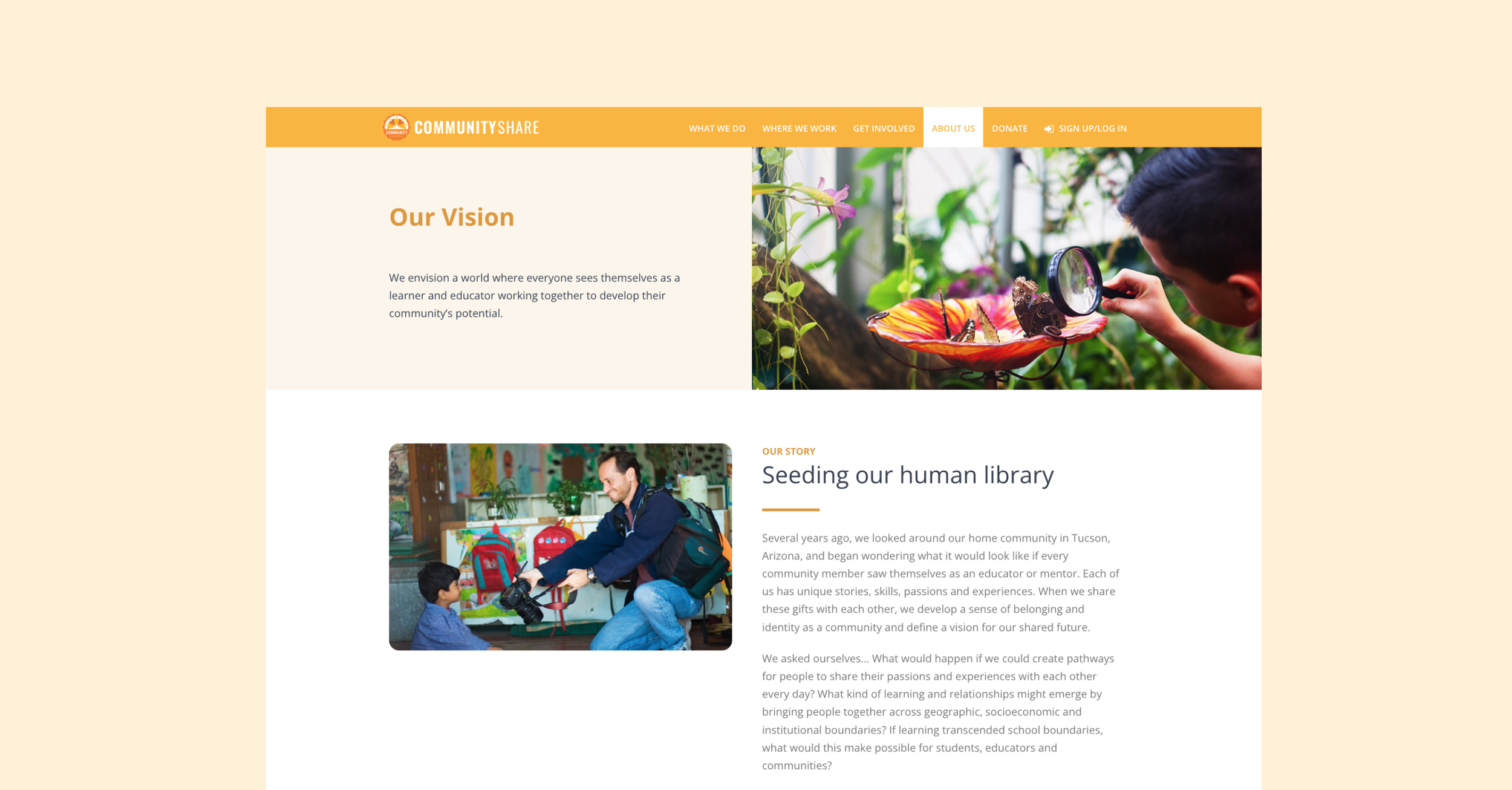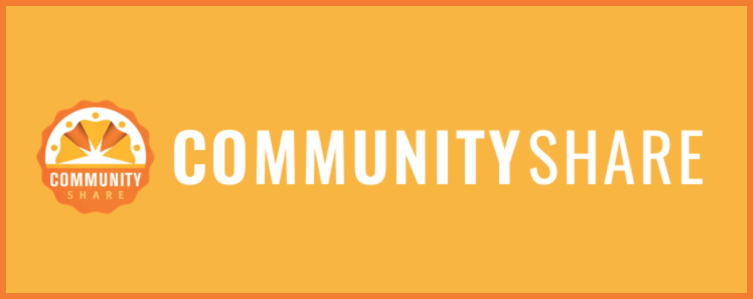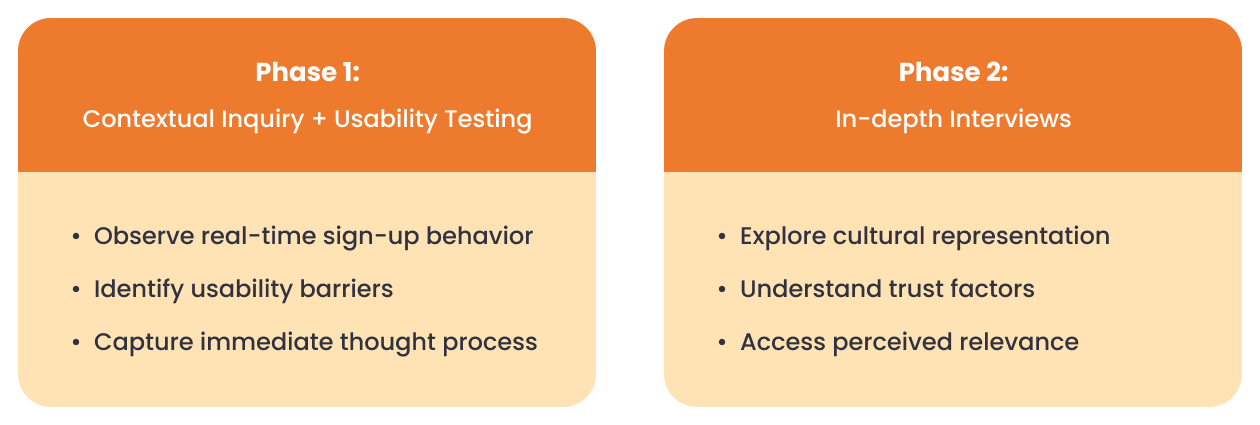CommunityShare: Designing an Inclusive Student Onboarding Experience
CommunityShare is a non-profit connecting students to local professionals through their teachers, bridging geographic, socioeconomic, and institutional boundaries. The goal is to help students, especially in underserved communities, discover real-world professions and see pathways for their futures.
When I joined the project, CommunityShare faced a critical challenge:
How might we increase signups, engagement, and retention among high school students, especially Latino students, so they feel represented, connected, and inspired by the platform?
PROJECT DETAILSTools: Miro, Figjam
Website: Visit Live Site
Role: UX Researcher, Strategist
Platform: Web

RRESEARCH PROCESS1. From Vision to Metrics: Aligning Stakeholders to Drive Student Engagement and Representation
During my stakeholder alignment sessions with the Executive Director and program managers, it became clear that the existing student onboarding process wasn’t achieving its intended impact. While teachers were introducing the platform in classrooms, the number of students actually creating accounts and engaging long-term was below expectations. A key assumption emerged from leadership during this session, that while CommunityShare was founded to be inclusive, the student experience wasn’t reflecting the cultural and lived experiences of many of its users.
We reviewed CommunityShare’s pre-existing analytics and survey feedback from educators, which revealed two major gaps:
A lack of cultural resonance for many Latino students
A sign-up flow that created friction rather than excitement
From there, I facilitated a collaborative goal-setting workshop to translate the organization’s mission into measurable UX outcomes. This ensured that the research I conducted would directly inform design changes tied to business metrics.
Stakeholders wanted to:
Increase student signups by at least 25% in the following year
Improve retention and ongoing engagement with the platform by increasing 3-month active user retention from 10% to 20%
Ensure underserved students feel represented in the experience by achieving a minimum of 75% positive response to ‘I see myself represented on the platform’ in post-onboarding surveys
2. A Two-Phase Approach to Uncover Barriers and Build Trust: I designed a research plan to reveal both functional friction and cultural disconnects in the student onboarding experience.
To address the challenge, I developed a two-phase research plan that balanced uncovering usability barriers with exploring deeper cultural and emotional connections students had, or didn’t have, with the platform.
Phase 1: In the first session, I conducted virtual contextual inquiries combined with moderated usability testing of the previous sign-up flow. This approach allowed me to observe where students struggled through screen sharing while they navigated the onboarding process, and to hear their thought process in real time by encouraging them to think aloud.
Phase 2: In the second session, I conducted in-depth interviews focused on cultural representation, trust, and relevance. Since some students were Spanish-first speakers, I conducted several interviews primarily in Spanish to ensure they felt comfortable and could provide detailed feedback. These conversations went beyond the interface to explore how students perceived the platform’s purpose and whether it reflected their lived experiences.
My process included:
Recruiting 12 high school students from predominantly Latino communities in Arizona, 6 who have used the platform and 6 who were new to the platform, ensuring they reflected the audience CommunityShare aimed to better serve
Designing a semi-structured interview script to capture both practical usability issues and more nuanced emotional disconnects
Creating a test protocol that evaluated the onboarding experience against three key criteria: clarity, inclusivity, and motivation to complete the process
3. Listening to Students, Seeing the Gaps: How usability testing revealed cultural, linguistic, and structural barriers to engagement.
I remotely moderated all 1:1 contextual inquiries combined with usability testing of the previous sign-up flow, where students walked me through their experience via screen share. This allowed me to observe their interactions in real time and capture key moments of confusion, hesitation, or disengagement within their natural digital environments.
Key Pain Points from contextual inquiries combined with usability testing:
Surfaced Motivations & Priorities: Some students skipped optional profile details or hesitated when reading onboarding copy because the original platform didn’t feel culturally relevant and used language that assumed prior knowledge, highlighting that signing up isn’t just about access but about feeling seen, welcome, and understood.
Revealed contextual factors: Students paused or disengaged when encountering formal, jargon-heavy language about careers or resources because it clashed with their lived experiences, especially for first-gen or Spanish-first speakers, showing that onboarding must feel context-aware and accessible rather than alienating.
Once the task flow was complete, I transitioned into exploratory questions to better understand their perceptions of the platform, probing for how well they felt represented, what they thought about the journey, and what value they saw in using it, if any.
Key Pain Points from in depth interviews:
Lack of Representation: The imagery and featured stories primarily reflected white, suburban experiences, which made several students say the platform “didn’t feel like it was for me.”
Language & Tone Disconnect: Copy assumed familiarity with career paths and networking norms often unfamiliar to first-generation students. One participant described it as “written for people who already know the system.”
Teacher-Mediated Sign-Up: Students didn’t sign up without a teacher initiating the process, creating dependency and sometimes long delays. This removed a sense of ownership and lowered enthusiasm.
SYNTHESIS & COLLABORATIONMapping Barriers, Unlocking Opportunities: Transforming Student Onboarding Through an Equity-Driven, Insight-Led Approach
After completing the research sessions, I led a comprehensive readout workshop with the product designer and key leadership stakeholders. This collaborative session was pivotal in translating a large volume of raw student feedback into actionable insights that directly informed design strategy.
We used a structured “barriers vs. motivators” framework to map out pain points alongside potential opportunities. This approach helped the team clearly see where students faced obstacles and where the platform could inspire and empower them.
My role was multifaceted:
Identifying patterns in student feedback: I organized qualitative data and usability observations into recurring themes, highlighting specific points of confusion, exclusion, and friction that Latino students experienced during onboarding.
Distilling insights from patterns: I translated those recurring patterns into deeper insights by uncovering the “why” behind student behaviors, such as how lack of cultural representation didn’t just cause disengagement but signaled to students that the platform wasn’t built with them in mind.
Prioritizing issues by potential impact: I guided the team to focus on the most critical friction points that would drive measurable increases in signups and retention, balancing quick wins with longer-term design goals.
DESIGN INFLUENCE AND OUTCOMESI collaborated closely with the product designer to ensure student feedback shaped the next version of CommunityShare’s platform.
During our research readout, I led a synthesis session where I mapped student pain points to opportunities using the “Barriers vs. Motivators” framework. I then presented how those opportunities could translate into actionable design strategies, ensuring our solutions were functional and also culturally resonant and emotionally inclusive.
Reframe onboarding as a personal welcome, not a transaction
Students described the original sign-up flow as cold, generic, and form-heavy. It felt like “signing up for homework,” not a place they were excited to join. We reimagined onboarding as a warm, story-driven welcome—with prompts that acknowledged students’ aspirations and invited them in, rather than requesting data upfront.
Feature student profiles and success stories from diverse backgrounds
Participants shared they didn’t feel seen on the platform. I recommended showcasing stories and visuals of Latino students on the homepage, who looked like them, came from similar neighborhoods, and had found value in connecting with mentors. This helped bridge the “representation gap” and built instant credibility.
Simplify the sign-up process so students could initiate directly
The teacher-mediated entry point created too much friction. Some students never completed onboarding because their teacher didn’t follow up. I proposed a student-initiated flow that allowed students to explore and start the journey independently, with teacher involvement becoming additive, not mandatory.
Use conversational, encouraging language
The original copy was institutional and assumed a level of familiarity with professional networking that many first-generation students lacked. I recommended a tone shift: using plain language, first-person prompts (“I want to explore careers in…”), and affirming feedback that guided students with clarity and encouragement.
ORGANIZATIONAL IMPACTBy rooting design in student voice, we redefined how CommunityShare measures success, shifting from mere conversions to authentic connection
After presenting these recommendations to the broader team, including the Executive Director, designer, and program managers, it sparked a mindset shift. CommunityShare began rethinking its student-facing experience as an invitation to belong, rather than a technical process to complete.
Although the full rollout of the V4 site occurred after my engagement ended, I checked back in with the team post-launch. Within just three months, they reported a 30% increase in student sign-ups and a 2× improvement in return visits, signaling that the redesigned experience was more inclusive, engaging and effective.
NEXT STEPS & HANDOFFSetting the team up for long term success
As my engagement with CommunityShare concluded, my goal was to ensure the research influenced the immediate redesign and continued to shape the product’s evolution over time.
To that end, I delivered a set of structured handoff materials and strategic recommendations that the team could implement with or without a full-time researcher on board.
Final Deliverables Included:
A prioritized backlog of onboarding improvements
Organized by impact and level of effort, this list helped the team focus on the highest-value changes—starting with simplifying the sign-up flow and integrating diverse student stories.A style guide for culturally representative imagery and language
I created a reference document that outlined visual and verbal cues to ensure ongoing alignment with the lived experiences of Latino students. This included voice & tone principles, photo sourcing guidance, and inclusive language dos/don’ts.Recommendations for continuous student feedback loops
I advised the team to set up lightweight, recurring feedback mechanisms (e.g., student interviews, embedded surveys) to ensure the platform continues to reflect student needs beyond launch.
Suggested Future Work:
These ideas were shared to help the team iterate beyond the MVP and build long-term equity into the platform:
A/B testing variations of the new sign-up flow
To measure which onboarding elements drive the highest engagement, especially for students from underserved communities.An ongoing student ambassador program
Engaging students directly to serve as platform advisors and content contributors, helping maintain authentic representation while fostering deeper buy-in.Analytics tracking by demographic segments
I encouraged setting up dashboards to track conversions, retention, and engagement over time, disaggregated by race/ethnicity, geography, and school type, to continuously assess equity and effectiveness.
REFLECTIONRepresentation is not optional, it’s the foundation for meaningful engagement and lasting impact.
This project reinforced a powerful truth: representation and inclusion aren’t just “nice-to-have” features — they are fundamental drivers of product adoption, trust, and long-term retention. Too often, platforms designed without authentic input from underserved communities risk alienating the very users they aim to serve.
By intentionally centering the voices of Latino students throughout the research and design process, we uncovered barriers that might have otherwise gone unnoticed, whether in imagery, language, or sign-up flows. This approach shifted CommunityShare’s student experience from a generic, transactional interaction into a meaningful invitation to belong.
Beyond improving metrics, this work deepened the organization’s understanding of its audience and strengthened its commitment to equity. It demonstrated how inclusive design practices are critical not only for usability but for creating emotional resonance and trust, essential ingredients for empowering students to envision and pursue their futures.
Ultimately, this project was a reminder that authentic representation must be woven into the very fabric of a product, not layered on as an afterthought. It’s a vital step toward fulfilling CommunityShare’s mission of bridging opportunity gaps and opening pathways for all students.






